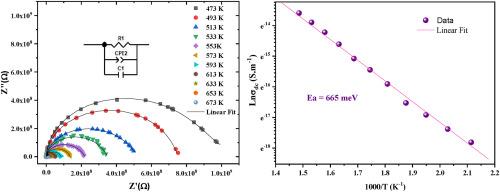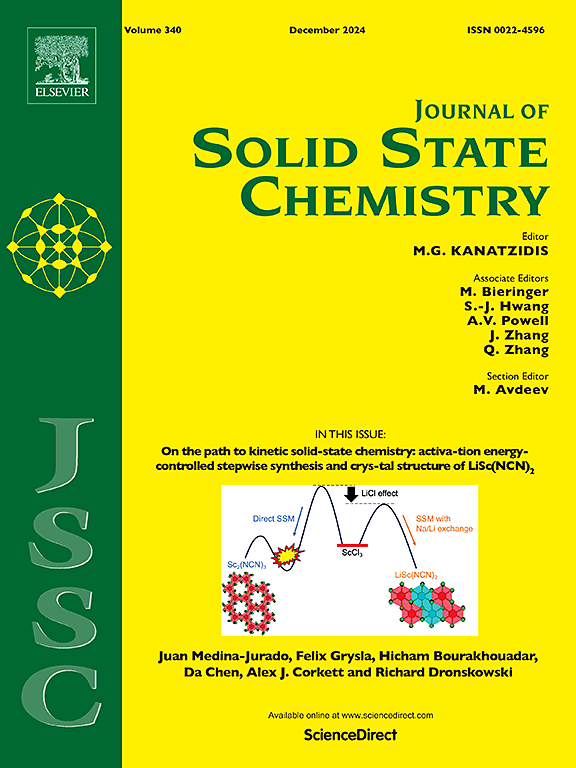Study on structural and conduction behavior of overlapping polaron tunnel of SrZnP2O7
IF 3.2
3区 化学
Q2 CHEMISTRY, INORGANIC & NUCLEAR
引用次数: 0
Abstract
The pyrophosphate compound family has garnered considerable attention recently due to their versatile properties. In this research, our focus was to investigate the structural, morphological, and electrical characteristics of the ceramic compound SrZnP2O7 which is elaborated via the solid-state process. X-ray diffraction reveals that the compound has a well-defined crystalline structure in the monoclinic phase having a P121/n1 space group. Scanning electronic microscope and energy dispersive spectroscopy reveals the purity of structure with particle size around 490 nm. The study of complex impedance spectra shows that the electrical properties of SrZnP2O7 sample are heavily dependent on frequency and temperature, indicating a relaxation phenomenon and semiconductor-type behavior. The frequency-dependent "ac" conductivity, evaluated using Jonscher's law, was built to be temperature-dependent. The curves of imaginary parts of impedance (Z″) and modulus (M″) show dielectric-relaxation phenomenon in the sample with activation energy near to that determined from the dc conductivity study. The conduction mechanism is conclusively governed by the overlapping large polaron tunneling model. Additionally, accurate computation of thermodynamic parameters such as enthalpy change (ΔH), entropy change (ΔS), and free energy of activation (ΔF) contributes further insights into the compound's properties. The findings demonstrate that SrZnP2O7 holds significant potential for various technological applications, including low-temperature co-fired ceramics, microwave technologies, and fuel cells.

SrZnP2O7 重叠极子隧道的结构和传导行为研究
焦磷酸盐化合物家族因其多变的特性,近来备受关注。在这项研究中,我们的重点是研究通过固态工艺制备的陶瓷化合物 SrZnP2O7 的结构、形态和电气特性。X 射线衍射显示,该化合物具有定义明确的单斜晶相晶体结构,空间群为 P121/n1。扫描电子显微镜和能量色散光谱显示,该化合物结构纯净,粒径约为 490 纳米。复阻抗光谱研究表明,SrZnP2O7 样品的电学特性严重依赖于频率和温度,这表明了一种弛豫现象和半导体型行为。用容舍尔定律评估的与频率有关的 "交流 "电导率与温度有关。阻抗(Z″)和模量(M″)的虚部曲线显示了样品中的介电松弛现象,其活化能接近于直流电导研究中确定的活化能。传导机制最终由重叠大极子隧道模型所控制。此外,热力学参数(如焓变(ΔH)、熵变(ΔS)和活化自由能(ΔF))的精确计算有助于进一步了解化合物的特性。研究结果表明,SrZnP2O7 在包括低温共烧陶瓷、微波技术和燃料电池在内的各种技术应用中具有巨大潜力。
本文章由计算机程序翻译,如有差异,请以英文原文为准。
求助全文
约1分钟内获得全文
求助全文
来源期刊

Journal of Solid State Chemistry
化学-无机化学与核化学
CiteScore
6.00
自引率
9.10%
发文量
848
审稿时长
25 days
期刊介绍:
Covering major developments in the field of solid state chemistry and related areas such as ceramics and amorphous materials, the Journal of Solid State Chemistry features studies of chemical, structural, thermodynamic, electronic, magnetic, and optical properties and processes in solids.
 求助内容:
求助内容: 应助结果提醒方式:
应助结果提醒方式:


